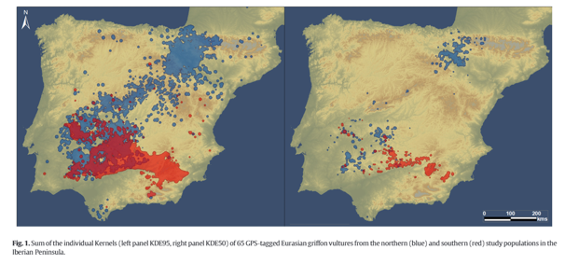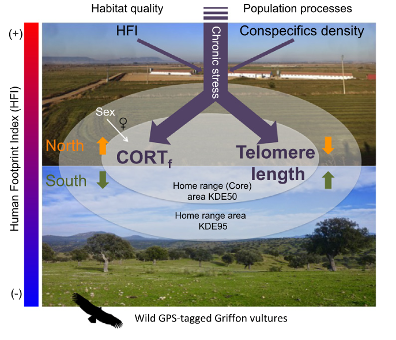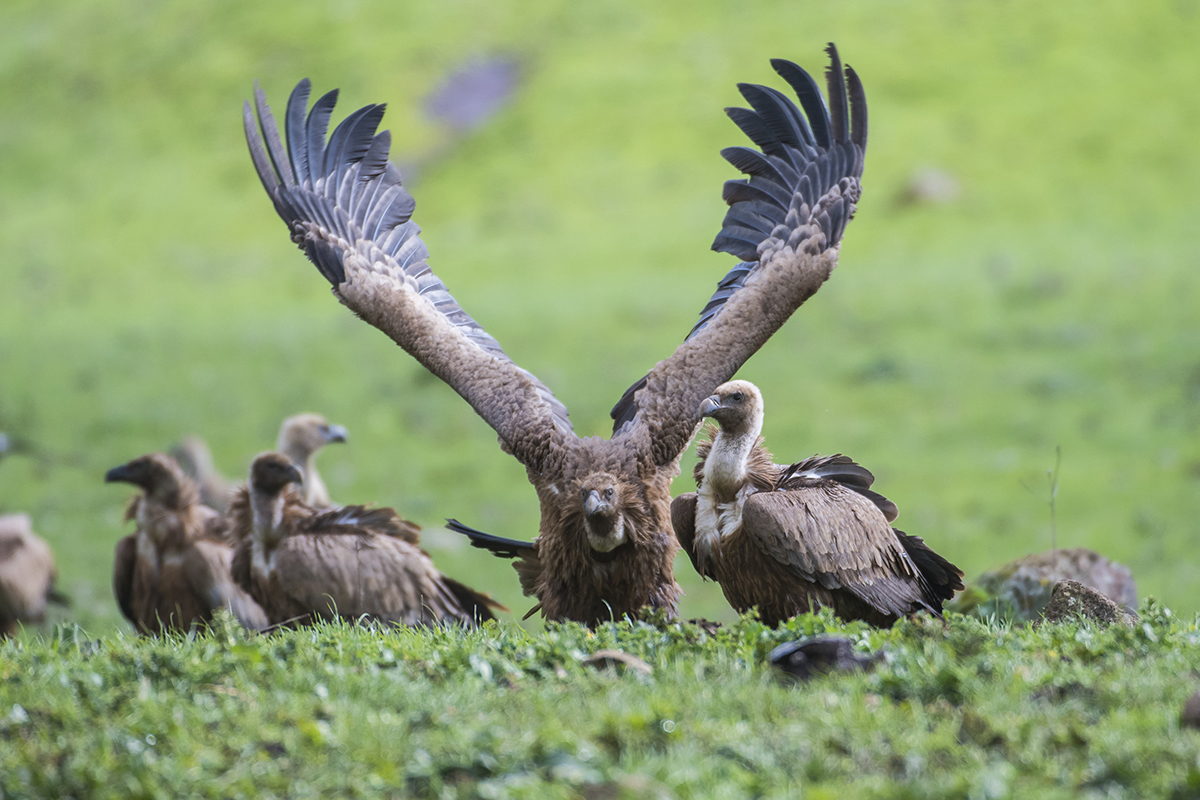
How does landscape anthropization affect vulture populations? A recently published research article investigated this question and revealed fascinating results linking movement behaviour, habitat and stress in Griffon Vultures.
Overview
Aanthropization, the large-scale transformation of natural ecosystems by human action, causes habitat loss and fragmentation, a major threat to biodiversity worldwide. However, the mechanisms linking landscape anthropization to population declines remain poorly understood in large vertebrates. Vultures, as top avian scavengers are particularly vulnerable to these anthropogenic factors. For example, a recent study (Arredondo et al. 2020) showed that Eurasian Griffon Vultures (Gyps fulvus) foraging in more anthropized areas had lower individual survival. This result was mainly explained by higher non-natural mortality in these areas like collision with vehicles, poisoning, and electrocution. But what are the physiological mechanisms linking anthropogenic disturbance, stress, individual condition, and survival in these populations?
In vertebrates, stress can operate through 1) short-term increases in glucocorticoid hormones, which are part of the individual response to environmental stress; and 2) increased cell ageing, which results in shorter telomeres at the end of chromosomes.
Chronic stress derived from anthropogenic disturbance is likely to have stronger effects on wildlife populations than stress caused by natural factors. However, the response to anthropogenic and environmental stressors and how they affect natural populations is species-specific. It is, therefore, crucial to further our understanding of these processes to improve wildlife conservation.
In this study, the research team led by Dr. Laura Gangoso from the Complutense University of Madrid aimed to take a step further by investigating how landscape anthropization and other ecological and individual factors influenced corticosterone levels and telomere length in Griffon Vultures.
Methods
Between 2014 and 2016, 65 Griffon Vultures were captured in the Southern Iberian Peninsula, in two areas with different levels of human landscape transformations (north/south, see maps below). All birds were equipped with GPS transmitters. In addition, the authors collected a 5ml blood sample and a scapular feather from each captured individual. Then the research team evaluated the levels of corticosterone (the primary glucocorticoid hormone in birds) deposited in feathers, CORTf, and determined telomere length using DNA extracted from red blood cells. They also estimated the core (small-scale) and home range (large-scale) areas of the GPS-tagged vultures. Finally, the authors quantified the level of anthropization for each individual at these two spatial scales using the Human Footprint Index (HFI). Data from the Griffon Vulture census database of 2008 were used to calculate the mean number of conspecifics/km2 for both home range estimators.

Results
Overall, levels of corticosterone and telomere length differed between the two areas. The northern population had higher CORTf levels and shorter telomeres than the southern population. HFI and conspecific density also showed higher values in the northern population.
The results further revealed that location (north/south) and sex both affected CORTf levels in Griffon Vultures. Levels of CORTf were higher in the northern (less anthropized) population and males had lower CORTf levels than females. In addition, location and conspecific density also influenced telomere length. Birds from the northern area had shorter telomeres and telomere length was also negatively associated with the density of conspecifics at the home range scale.

Conclusions and Recommendations
This study’s results revealed that anthropization might be linked to several cost-benefits for vultures. On one hand, vultures foraging in anthropized areas had a lower home range and higher body condition. This might be linked to higher food availability and predictability in these sites, for example through access to landfills and intensive livestock farms. On the other hand, vultures foraging in anthropized areas were also more stressed (higher CORTf levels) and were in poorer individual condition (shorter telomeres). An increased access to low-quality food, ingestion of pollutants and increased competition for resources due to a high density of conspecifics could translate into such levels of chronic stress. Further research is needed to understand sex-associated differences in the levels of CORTf and how they cascade at the population level.
The results presented here bring further insights on the way anthropization affects health in vulture populations and suggest potential mechanisms linking habitat, stress and survival rates. This study highlights the relevance of combining tracking data with physiological parameters and large-scale ecological data to identify the potential ‘hidden’ costs of living in transformed habitats for vultures. This is crucial for designing efficient conservation measures for vulture species in European landscapes, one of the main goals of the Vulture Conservation Foundation (VCF).
Sources
Gangoso, L., Cortés-Avizanda, A., Sergiel, A., Pudifoot, B., Miranda, F., & Muñoz, J. et al. (2021). Avian scavengers living in anthropized landscapes have shorter telomeres and higher levels of glucocorticoid hormones. Science Of The Total Environment, 782, 146920. https://doi.org/10.1016/j.scitotenv.2021.146920
Arrondo, E., Sanz-Aguilar, A., Pérez-García, J., Cortés-Avizanda, A., Sánchez-Zapata, J., & Donázar, J. (2020). Landscape anthropization shapes the survival of a top avian scavenger. Biodiversity And Conservation, 29(4), 1411-1425. https://doi.org/10.1007/s10531-020-01942-6



